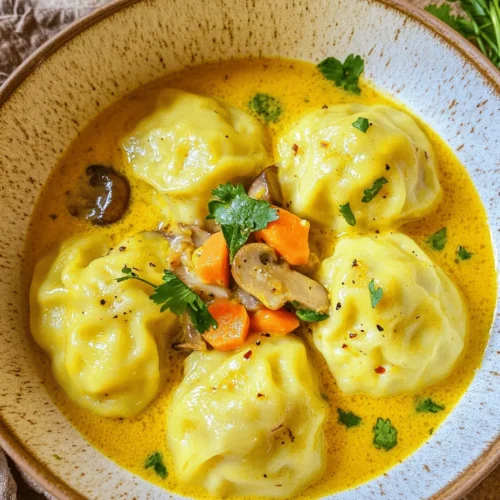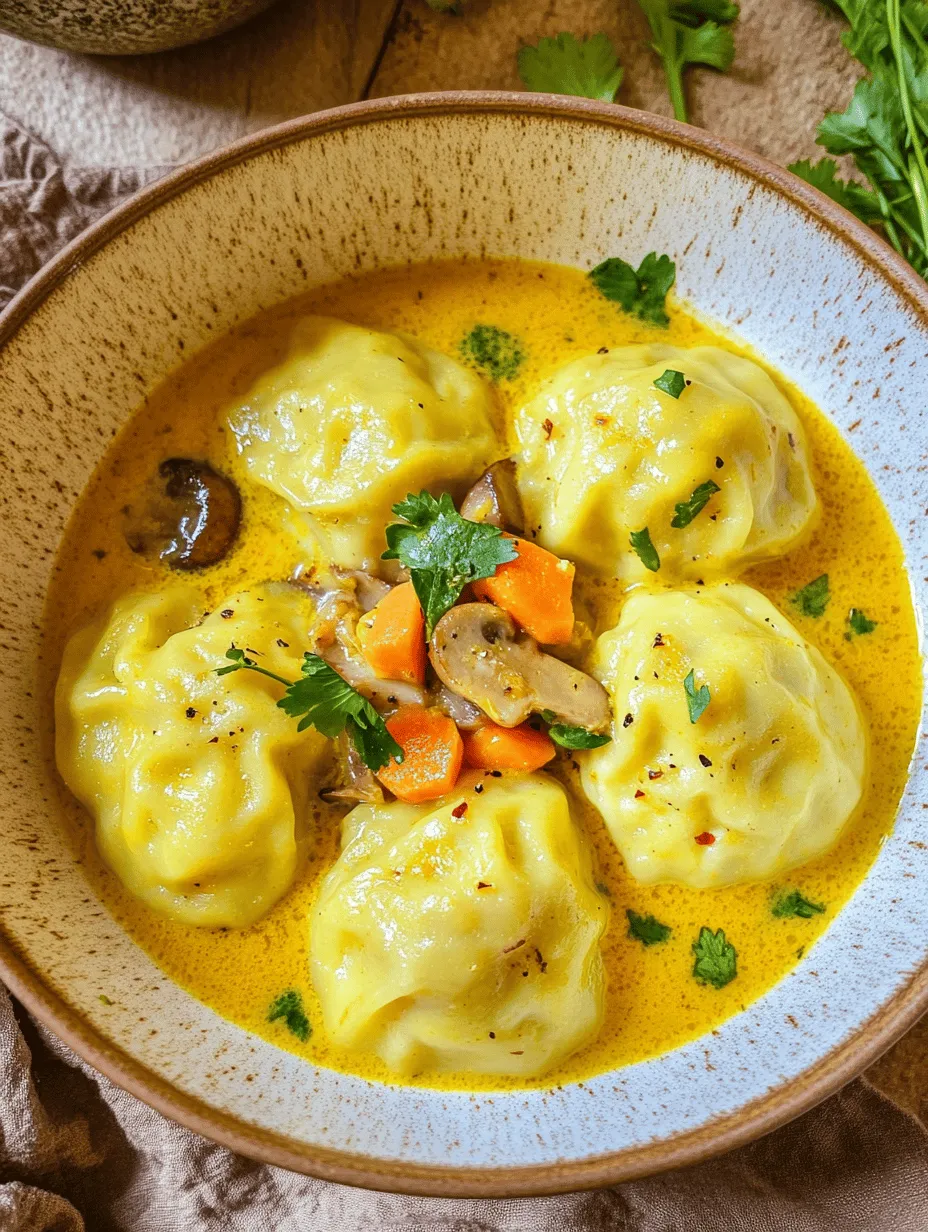Introduction
Curry dumpling soup is more than just a dish; it’s a warm embrace in a bowl. The combination of savory dumplings nestled in a fragrant, spiced broth is a culinary experience that transcends mere sustenance. This delightful soup is comfort food at its finest, perfect for chilly evenings or when you’re in need of a cozy pick-me-up.
Dumplings have a rich cultural significance across numerous cuisines, from Asian to Eastern European traditions, where they are often associated with family gatherings, celebrations, and nurturing home-cooked meals. Each region has its unique spin, but the essence remains the same: dumplings symbolize comfort and togetherness.
In addition to their comforting qualities, the ingredients in this curry dumpling soup are packed with health benefits. The vibrant vegetables provide essential vitamins and minerals, while the spices used in the curry not only add flavor but also have anti-inflammatory properties. Coconut milk, a key ingredient in this recipe, is rich in healthy fats and offers a creamy texture that enhances the soup’s richness. With each spoonful, you’re not only indulging in a delicious meal but also nourishing your body.
In this article, we will guide you through the process of making the best curry dumpling soup at home, encouraging you to embrace the joy of cooking and the warmth of this delightful dish.
Understanding the Ingredients
Before diving into the cooking process, it’s essential to understand the primary ingredients that make this curry dumpling soup so special. Each component plays a crucial role in flavor, texture, and nutritional value.
All-Purpose Flour
All-purpose flour is the foundation of the dumpling dough. It provides the structure necessary for creating the perfect dumpling. When mixed with water, the proteins in the flour develop gluten, which gives the dough its elasticity and chewiness. This combination is what allows the dumplings to hold together while cooking and maintain their shape.
Vegetables
The vegetables you choose for the filling not only contribute to the flavor but also offer an array of health benefits. Common choices include carrots, bell peppers, and green onions. Carrots are rich in beta-carotene, which is beneficial for eye health, while bell peppers provide vitamin C and antioxidants. Green onions add a mild, fresh taste and are also a source of vitamins A and K.
Coconut Milk
Coconut milk serves as a creamy base for the soup, providing a subtle sweetness and richness that complements the spices. Beyond its unique flavor, coconut milk is an excellent source of medium-chain triglycerides (MCTs), which can provide quick energy and support metabolic health. Additionally, it contains lauric acid, which has antimicrobial properties.
Aromatic Ingredients: Ginger, Garlic, and Curry Powder
No curry dish is complete without the aromatic trio of ginger, garlic, and curry powder. Ginger adds a warm, zesty flavor and is known for its digestive benefits. Garlic not only enhances flavor but is also celebrated for its immune-boosting properties. Curry powder, a blend of spices that may include turmeric, cumin, and coriander, infuses the soup with warmth and complexity while offering various health benefits, such as anti-inflammatory effects.
Fresh Herbs: Coriander
Fresh herbs like coriander (also known as cilantro) are essential for adding brightness and freshness to the dish. Coriander is rich in antioxidants and contains vitamins A, C, and K. Its distinct flavor complements the spices and balances the richness of the coconut milk, making it an indispensable component of the soup.
Preparing the Dumpling Dough
Now that we understand the ingredients, we can begin preparing the dumpling dough. The process is simple but requires attention to detail to achieve the perfect texture.
Step 1: Gather Your Ingredients
To make the dumpling dough, you will need:
– 2 cups all-purpose flour
– 1/2 teaspoon salt
– 3/4 cup hot water
Step 2: Combine Flour and Salt
In a large mixing bowl, combine the all-purpose flour and salt. Mix well to ensure that the salt is evenly distributed throughout the flour.
Step 3: Add Hot Water
Gradually pour in the hot water while stirring the mixture with a fork or chopsticks. The hot water helps to activate the gluten in the flour, making the dough more elastic.
Step 4: Knead the Dough
Once the mixture begins to come together, transfer it to a lightly floured surface. Knead the dough for about 5-10 minutes until it becomes smooth and elastic. This step is crucial, as proper kneading develops the gluten structure that gives the dumplings their chewy texture.
Step 5: Rest the Dough
After kneading, wrap the dough in plastic wrap or cover it with a damp cloth. Allow it to rest for at least 30 minutes. Resting is essential because it relaxes the gluten, making the dough easier to roll out and shape into dumplings.
Step 6: Check the Dough Consistency
After resting, the dough should be pliable and slightly tacky but not sticky. If it feels too dry, you can add a small amount of water, one teaspoon at a time, until the desired consistency is reached. Conversely, if it’s too sticky, sprinkle in a bit more flour.
Visual Cues
As you work with the dough, look for visual cues to ensure it’s the right consistency. The dough should hold together without cracking at the edges. When you press it with your finger, it should spring back slightly—this indicates that the gluten has developed properly.
Making the Dumpling Filling
With the dumpling dough ready, it’s time to prepare the filling. The filling is where you can get creative and personalize your dumplings with various flavors and textures.
Step 1: Choose Your Vegetables
For the filling, you can use a combination of your favorite vegetables. Here’s a simple filling recipe to get you started:
– 1 cup finely chopped carrots
– 1 cup finely chopped bell peppers
– 1/2 cup finely chopped green onions
– 1 tablespoon soy sauce
– 1 teaspoon sesame oil
– Salt and pepper to taste
Step 2: Sauté the Vegetables
In a large skillet, heat a tablespoon of oil over medium heat. Add the chopped vegetables and sauté for 3-4 minutes until they soften but still retain their color and crunch. Avoid overcooking, as this can lead to nutrient loss.
Step 3: Season the Filling
Once the vegetables are sautéed, remove them from the heat and let them cool slightly. Add the soy sauce, sesame oil, salt, and pepper to the mixture, stirring well to combine. The soy sauce adds depth and umami to the filling, while sesame oil lends a nutty flavor.
Step 4: Adjust to Taste
Feel free to experiment with different vegetables or herbs based on your preference. For a spicier kick, consider adding diced chili peppers or a dash of chili sauce. If you prefer a more savory filling, you can incorporate mushrooms or tofu for additional protein.
Cooking Techniques
To preserve the nutrients in the vegetables, avoid boiling them for long periods. Steaming or sautéing briefly helps maintain their vibrant colors and health benefits.
Forming the Dumplings
Now that you have your dumpling dough and filling ready, it’s time to bring everything together and shape your dumplings.
Step 1: Roll Out the Dough
On a lightly floured surface, divide the rested dough into smaller portions. Roll each portion into a thin sheet, about 1/8 inch thick. Use a round cutter or a glass to cut out circles from the dough, typically around 3 inches in diameter.
Step 2: Fill the Dumplings
Place a small spoonful of the vegetable filling in the center of each dough circle. Be careful not to overfill, as this can make it difficult to seal the dumplings properly.
Step 3: Seal the Dumplings
To seal the dumplings, moisten the edges of the dough circle with a little water. Fold the dough over the filling to create a half-moon shape. Press the edges firmly together to seal, ensuring there are no air pockets inside. For added security, you can crimp the edges with a fork or pinch them decoratively.
Step 4: Prepare for Cooking
Once all the dumplings are shaped, set them aside on a parchment-lined tray to prevent sticking. You can also freeze them at this stage if you wish to enjoy them later; just ensure they are in a single layer.
With the dumplings formed, you’re on your way to creating a delicious bowl of curry dumpling soup. In the next section, we will guide you through the process of making the flavorful curry broth that will elevate your dish to new heights. Stay tuned for the next steps!

Tips for Sealing Dumplings Effectively
Sealing dumplings is a crucial step in ensuring they retain their filling while cooking and do not leak. Here are some tips to help you achieve a perfect seal:
1. Moisten the Edges: Before folding the dumpling, dab a small amount of water along the edges of the wrapper. This moisture helps the edges stick together, creating an airtight seal.
2. Use the Right Amount of Filling: Overfilling the dumpling can lead to leaks during cooking. A good rule of thumb is to use about a teaspoon of filling for each dumpling, allowing enough space for sealing.
3. Pinch and Fold: When sealing, start at one end and pinch the edges together. Use your fingers to fold small pleats along the edge as you move toward the other end. This not only strengthens the seal but also adds an aesthetic touch.
4. Press Firmly: After pinching and folding, firmly press the edges together to ensure they are sealed tightly. You can also use a fork to press down along the edges for added security.
5. Let Them Rest: Once sealed, let the dumplings rest on a floured surface for a few minutes before cooking. This allows the dough to firm up slightly, reducing the chance of breaking during cooking.
Variations in Dumpling Shapes and Their Cultural Implications
Dumplings come in various shapes, each holding cultural significance. In Chinese cuisine, for instance, dumplings are often pleated and folded into crescent shapes, symbolizing wealth and prosperity. In contrast, Japanese gyoza are usually pan-fried and have a flat bottom, representing a different cooking technique and cultural practice.
Korean mandu are often shaped like little purses, showcasing the artistry of the dumpling-making process. Exploring different shapes not only adds visual appeal but also reflects the diversity of culinary traditions worldwide. Try experimenting with different shapes as you create your dumplings, and consider how each shape may enhance your dish’s presentation.
Suggested Ways to Store or Freeze Dumplings for Future Meals
If you find yourself with leftover dumplings or want to prepare ahead of time, storing or freezing them is an excellent option.
1. Refrigeration: Store uncooked dumplings in an airtight container in the refrigerator for up to 24 hours. Ensure they are not touching each other to avoid sticking. When ready to cook, simply steam or boil them as you normally would.
2. Freezing: For longer storage, freeze dumplings in a single layer on a baking sheet for about 1-2 hours until solid. Once frozen, transfer them to a freezer-safe bag or container. Properly stored, they can last for up to three months.
3. Cooking from Frozen: There’s no need to thaw frozen dumplings before cooking. Simply add them to the boiling soup directly from the freezer, allowing an additional few minutes of cooking time to ensure they are heated through.
Crafting the Curry Soup
Creating the perfect soup base is essential for complementing the flavors of your dumplings. Follow these step-by-step instructions for a delicious curry soup:
1. Sauté Aromatics: Begin by heating a tablespoon of oil in a large pot over medium heat. Add 1 diced onion and sauté for about 5 minutes until translucent. This step is critical as it lays the foundation for the soup’s flavor profile.
2. Add Spices: Once the onions are ready, stir in a tablespoon of minced garlic, a tablespoon of fresh ginger, and your choice of spices—typically, a tablespoon each of curry powder and ground cumin works well. Sauté these for an additional minute until fragrant.
3. Incorporate Broth: Pour in 4 cups of vegetable or chicken broth, stirring well to combine with the sautéed mixture. The broth will serve as the base for your curry soup, enhancing the overall flavor.
4. Balance Flavors: To achieve a well-rounded taste, add a tablespoon of soy sauce, the juice of one lime, and season with salt and pepper to your liking. Taste and adjust as necessary; the balance of acidity from the lime and umami from the soy sauce is key to a delicious soup.
5. Add Coconut Milk: For creaminess, pour in a can (13.5 oz) of coconut milk. Stir until fully incorporated. The coconut milk not only enhances the soup’s texture but also provides a rich, comforting flavor that pairs beautifully with the spices.
6. Simmer: Allow the soup to simmer on low heat for about 10 minutes, letting the flavors meld together. This step is important as it deepens the flavor of the soup.
Cooking the Dumplings in the Soup
Once your soup base is ready, it’s time to cook the dumplings. Here’s how to do it correctly:
1. Introduce Dumplings Gently: With the soup simmering, carefully add the dumplings one at a time. Use a slotted spoon to lower them into the pot, ensuring they do not stick to each other.
2. Cooking Time: Allow the dumplings to cook for about 8-10 minutes. The timing can vary slightly depending on the thickness of your dumpling wrappers.
3. Check for Doneness: Dumplings are fully cooked when they float to the top of the soup and the dough is tender. You can also cut one open to check that the filling is heated through.
Final Touches and Presentation
Before serving your curry dumpling soup, consider these finishing touches:
1. Taste Adjustments: Before ladling the soup into bowls, taste once more and adjust the seasoning if necessary. A dash more lime juice or a pinch of salt can elevate the flavors.
2. Garnishing: Fresh coriander adds a vibrant flavor and a pop of color to your dish. Sprinkle a generous amount on top of each bowl just before serving.
3. Serving Suggestions: Pair your soup with crusty bread or a light side salad for a complete meal. The bread can be used to soak up the delicious broth, while the salad adds a fresh crunch.
4. Visual Presentation: Serve the soup in wide, shallow bowls to showcase the dumplings and garnishes beautifully. A drizzle of coconut milk on top can also enhance the presentation, making it look even more appetizing.
Cultural Variations and Alternatives
Curry dumpling soup is a versatile dish that can be adapted to various cultural interpretations:
1. Cultural Variations: Different cultures have their versions of dumpling soup. For example, Thai dumplings often incorporate fresh herbs like basil and serve with a spicy dipping sauce. Indian-inspired versions may include paneer or lentils in the dumpling filling, accompanied by a thicker curry sauce.
2. Dietary Alternatives: For those with dietary restrictions, consider using gluten-free dumpling wrappers or even making your own with rice flour. Vegan alternatives can include tofu or vegetable fillings, ensuring everyone can enjoy this comforting dish.
3. Unique Spices: Experiment with adding unique spices or herbs to your soup. A hint of turmeric can provide a beautiful color and health benefits, while fresh dill can add a refreshing twist.
Conclusion
The Best Curry Dumpling Soup is more than just a meal; it is a comforting dish that brings warmth and joy to the table. With its rich flavors and hearty dumplings, this recipe is perfect for cold days or gatherings with family and friends. The process of creating this dish from scratch not only fosters a sense of accomplishment but also allows you to explore your creativity in the kitchen.
Embrace home cooking and the joy it brings, knowing that this recipe has the potential to become a family favorite. So gather your ingredients, follow the steps, and enjoy the delightful experience of crafting your own curry dumpling soup. Don’t hesitate to experiment with flavors and ingredients, making this dish uniquely yours. Happy cooking!



